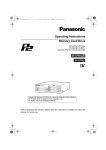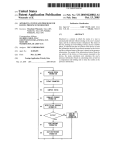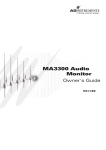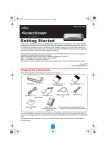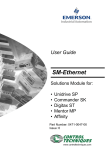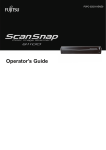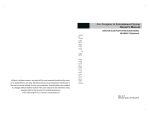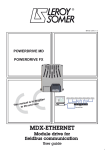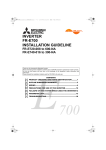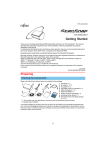Download Gateway none User's Manual
Transcript
Wireless Broadband Router User's Guide Version: 1.0 Aug. 2001 Copyright Statement No part of this publication may be reproduced, stored in a retrieval system, or transmitted in any form or by any means, whether electronic, mechanical, photocopying, recording or otherwise without the prior writing of the publisher.Windows 95/98 and Windows 2000 are trademarks of Microsoft Corp. Pentium is trademark of Intel. All copyright is reserved. TABLE OF CONTENTS 1 Introduction 1.1 About the Gateway...................................................... 1-2 1.2 Features and Benefits.................................................. 1-3 1.3 Applications................................................................. 1-4 2 Installation 2.1 Kit Contents................................................................ 2-2 2.2 Description of Hardware............................................ 2-3 2.3 System Requirements.................................................. 2-6 2.4 Connect the System..................................................... 2-7 2.4.1 Basic Installation Procedure....................................... 2-8 2.4.2 Attach to Your Network Using Ethernet Cabling...... 2-9 2.4.3 Attach to Your Network Using Radio Signals........... 2-11 2.4.4 Attach the Gateway to the Internet............................ 2-13 2.4.5 Connect the Gateway to a Printer.............................. 2-14 2.4.6 Connecting the Power Adapter.................................. 2-14 2.4.7 Verify Port Status....................................................... 2-15 3 CONFIGURING CLIENT TCP/IP 3.1 Installing TCP/IP Protocol in Your PC..................... 3-3 3.2 Setting TCP/IP to Work with the Gateway.............. 3-5 3.2.1 Dynamic IP Allocation via a DHCP Server............... 3-6 3.2.2 Manual IP Configuration............................................ 3-7 3.2.3 Verifying Your TCP/IP Connection........................... 3-9 4 CONFIGURING THE GATEWAY 4.1 Navigating the Web Browser Interface..................... 4-2 4.1.1 Setting a Password..................................................... 4-2 4.1.2 Making Configuration Changes................................. 4-3 4.2 Main Menu.................................................................. 4-4 4.3 Networking and Client Services................................. 4-6 4.3.1 Change Password....................................................... 4-7 4.3.2 Set Time Zone............................................................ 4-8 4.3.3 LAN Gateway and DHCP Settings............................ 4-9 4.3.4 WAN Configuration................................................... 4-10 4.3.4.1 Dynamic IP Address - DHCP................................. 4-11 4.3.4.2 Static IP Address - Fixed IP.................................... 4-12 4.3.4.3 PPP over Ethernet - PPPoE..................................... 4-13 4.3.4.4Dial-up on Demand - Modem.................................. 4-14 4.3.5 DNS Configuration.................................................... 4-16 4.3.6 Wireless Configuration.............................................. 4-17 4.3.6.1 Channel and SSID................................................... 4-18 4.3.6.1 Encryption............................................................... 4-19 4.3.7 Configuring Client Services..................................... 4-20 4.3.7.1 Firewall Protection.................................................. 4-22 4.3.7.2 Network Address Translation - NAT...................... 4-23 4.3.7.3 Virtual Server.......................................................... 4-24 4.3.7.4 Enabling Special Applications................................ 4-26 4.3.7.5 Virtual DMZ Host................................................... 4-28 4.3.7.6 Remote Management.............................................. 4-29 4.3.7.7 Client Filtering........................................................ 4-30 4.4 Viewing Network and Device Status......................... 4-31 4.5 Using System Tools...................................................... 4-32 5 CONFIGURING PRINTER SERVICES 5.1 Install the Printer Port Monitor................................ 5-2 5.2 Configure the Print Server......................................... 5-7 5.2.1 Configure the Network Printer in Windows 95/98.... 5-7 5.2.2 Configure the Network Printer in Windows NT........ 5-10 5.2.3 Configure the Network Printer in Windows 2000..... 5-13 5.2.4 Configure the Network Printer in Windows ME....... 5-23 5.2.5 Configure the Network Printer in Unix Systems....... 5-28 APPENDICES: A. Troubleshooting............................................................ A-1 B. Cables............................................................................. B-1 Ethernet Cable................................................................. B-1 Straight-through Cable.................................................... B-1 RJ-45 Port Pin Assignments........................................... B-2 Serial Port Pin Assignments............................................ B-3 Printer Port Pin Assignments.......................................... B-6 C. Specifications................................................................. C-1 Compliance......................................................................... C-5 Safety Compliance............................................................. C-7 INTRONDUCTION Thank you for purchasing our product, and we are proud to provide you with this powerful yet simple communication device for connecting your local area network (wired or wireless LAN) to the Internet. For those who want to surf the Internet at the lowest possible cost, this Broadband Router provides a convenient and powerful solution. This User's Guide introduces to you the common configurations of the Gateway and leads you through the installation step by step. Please read this manual to become familiar with this Gateway and its applications. This manual contains detailed instructions in the operation of this product. Please keep this manual for future reference. 1-1 CHAPTER 1 CHAPTER1 CHAPTER 1 1.1About the Gateway The Gateway provides Internet access to multiple users by sharing a single-user account. The Gateway's most outstanding features include wireless LAN connectivity, as well as the dual-port WAN interface which allows you to connect to an xDSL or Cable modem, ISDN TA or PSTN analog modem. The Gateway provides extensive firewall protection and Virtual Private Network (VPN) services. It also provides print services for any client attached to a LAN port. The Gateway supports dial-on-demand for ISDN/PSTN service, automatically connecting to the Internet when there are requests, and terminating the connection if no further requests occur. This dual-port design also supports fail-over Internet access through the secondary WAN port (i.e., the serial port can be used for primary or backup Internet access). This new Gateway technology provides many cost-effective functions and management benefits. It is simple to configure and can be up and running in minutes. 1-2 CHAPTER 1 1.2Features and Benefits zInternet access via 10 Mbps WAN port connection to xDSL/Cable modem, or RS232 console port connection to ISDN/PSTN modem zLocal Network Connection via zThree 10/100 Mbps Ethernet switch ports, or z11 Mbps wireless interface zBuilt-in Print Server for any client attached to the LAN zDHCP for dynamic IP configuration, and DNS for domain name mapping zFirewall - client privileges, hacker prevention, NAT zNAT also enables multi-user access with a single-user account, and virtual server functionality (providing protected access to Internet services such as Web, FTP, mail and Telnet) zMulti-user access (up to 253), single-user account zVirtual server with network address translation zVirtual Private Network support using PPTP, L2TP or IPSec pass-through. zUser-definable application sensing tunnel supports applications requiring multiple connections zSupports CHAP authentication protocol for dial-up identification zSupports PPP dial-in connection using standard dial-up program zEasy setup through a Web browser on any operating system that supports TCP/IP zCompatible with all popular Internet applications an Builtin Print Server support 1-3 CHAPTER 1 1.3Applications Many advanced applications are provided by the Gateway, such as: zFlexible LAN Access The Gateway provides connectivity to 10/100 Mbps wired devices as well as 11 Mbps wireless mobile users. The wireless interface makes it easy to create a network in difficult-to-wire environments, or to provide quick access to databases for mobile workers. zInternet Access This device supports Internet access through an xDSL, Cable, ISDN or PSTN connection. Since many xDSL providers use PPPoE to establish communications with end users, the Gateway includes a built-in client for this protocol, eliminating the need to install this service on your computer. zShared IP Address The Gateway provides Internet access for up to 253 users with a shared IP address. Using only one ISP account, multiple users on your network can browse the Web at the same time. zVirtual Server If you have a fixed IP address, you can set up the Gateway to act as a virtual host for network address translation. Remote users access various services at your site using a constant IP address. Then, depending on the requested 1-4 zUser-Definable Application Sensing Tunnel You can define special applications that require multiple connections such as videoconferencing, Internet gaming, and Internet telephony. The Gateway can then sense the application type and open a multi-port tunnel for it. zDMZ Host Support Allows a networked computer to be fully exposed to the Internet. This function is used when the special application sensing tunnel feature is insufficient to allow an application to function correctly. zSecurity The Gateway supports security features that can deny Internet access to specified users, or filter all requests for specific services the administrator does not want to serve. The Gateway's firewall can also block common hacker attacks, including IP Spoofing, Land Attack, Ping of Death, IP with zero length, Smurf Attack, UDP port loopback, Snork Attack, TCP null scan, and TCP SYN flooding. zVirtual Private Network The Gateway supports three of the most commonly used 1-5 CHAPTER 1 service (or port number), the Gateway can route the request to the appropriate server (at another internal IP address). This secures your network from direct attack by hackers, and provides more flexible management by allowing you to change internal IP addresses without affecting outside access to your network.. CHAPTER 1 VPN protocols - PPTP, L2TP and IPSec. These protocols allow remote users to establish a secure connection to their corporate network. If your service provider supports VPNs, then any of these protocols can be used to create an authenticated and encrypted tunnel for passing secure data over the Internet (i.e., a traditionally shared data network). The VPN protocols supported by the Gateway are briefly described below: *Point-to-Point Tunneling Protocol: Provides a secure tunnel for remote client access to a PPTP security gateway. PPTP includes provisions for call origination and flow control required by ISPs. *Layer Two Tunneling Protocol - Includes most of the features provided by PPTP, but has fewer overheads and is more suited for managed networks. *IP Security - Provides IP network-layer encryption. IPSec can support large encryption networks (such as the Internet) by using digital certificates for device authentication 1-6 CHAPTER2 INSTALLATION CHAPTER 2 Before installing the Gateway Wireless Broadband Router, verify that you have all the items listed under the "Kit Contents." If any of the items are missing or damaged, please contact your local distributor. Also be sure that you have all the necessary cabling before installing the Gateway. After installing the Gateway, refer to the Web-based configuration program in Chapter 4 "Configuring the Gateway" for information on configuring the router. 2-1 2.1 Kit Contents CHAPTER 2 After unpacking the Gateway Broadband Router, check the contents of the box and make sure you have received the following components: zGateway 4-port Wireless Broadband Router adapter (5V, 2.4A) zOne CAT-5 Ethernet cable zFour rubber feet zUser's Guide zPower Immediately inform your dealer in the event of any incorrect, missing or damaged parts. If possible, please retain the carton and original packing materials in case there is a need to return the product. 2-2 2.2 Description of Hardware CHAPTER 2 The main functions of the Gateway can be divided into three categories: 1.Connects to the Internet or to a remote site by using its RJ-45 WAN port or RS232 serial port. 2.Directly connects to your PC or to a local area network by using any of the three Fast Ethernet LAN ports or through the IEEE802.11b wireless interface. 3.Functions as a print server as well. Access speed to the Internet depends on your service type. Full-rate ADSL can provide up to 8 Mbps downstream and 640 Kbps upstream. G.lite (or splitterless) ADSL provides up to 1.5 Mbps downstream and 512 Kbps upstream. Cable modems can provide up to 36 Mbps downstream and 2 Mbps upstream. ISDN can provide up to 128 Kbps when using two bearer channels. And PSTN analog connections can now run up to 56 Kbps. However, you should note that the actual rate provided by specific service providers may vary dramatically from those above-mentioned limits. Although access speed to the Internet is determined by the modem type connected to your Gateway, data passing between devices connected to your local area network can run up to 100 Mbps over the Fast Ethernet ports. The Gateway includes an LED display on the front panel for system power and port indications that simplifies installation and network troubleshooting. It also provides three RJ-45 LAN ports, one RJ-45 WAN port, one RS232 serial 2-3 port, one parallel printer port, as well as two antennas on the rear panel. CHAPTER 2 zThree RJ-45 ports for connection to a 10BASET/100BASE-TX Ethernet Local Area Network (LAN). These ports can auto-negotiate the operating speed to 10/100 Mbps, the mode to half/full duplex, and the pin signals to MDI/MDI-X (i.e., allowing these ports to be connected to any network device with straight-through cable). These ports can be connected directly to a PC or to a server equipped with an Ethernet network interface card, or to a networking device such as an Ethernet hub or switch. zOne RJ-45 port for connection to an xDSL or Cable modem. This port is fixed at 10 Mbps, full duplex. zOne RS232 serial port to connect to an ISDN Terminal Adapter (TA) or to a PSTN analog modem. zOne parallel printer port that can be connected to a printer, which can be shared by any LAN/WLAN users. zTwo antennas. The following figure shows the components of the Gateway: 2-4 CHAPTER 2 2-5 2.3 System Requirements CHAPTER 2 You must have access to an ISP that meets the following minimum requirements: zInternet access from your local telephone company or Internet Service Provider (ISP) using an xDSL modem, Cable modem, ISDN TA, or PSTN analog modem. You may also have access over the telephone system to an analog modem at another site. zA PC using a fixed IP address or a dynamic IP address assigned by DHCP, a Gateway server address, and a DNS server address from your service provider. zFor wired LAN connection, you need a computer equipped with a 10 Mbps, 100 Mbps, or 10/100 Mbps Fast Ethernet card, or a USB-to-Ethernet converter. For wireless LAN connections, each computer must have an 11 Mbps wireless adapter. zTCP/IP network protocol installed on each PC that needs to access the Internet. zA Java-enabled Web browser, such as Microsoft Internet Explorer 5.0 or above or Netscape Communicator 4.0 or above installed on one PC at your site for configuring the Gateway. 2-6 2.4 Connect the System zKeep zDo the Gateway away from any heating devices. not place the Gateway in a dusty or wet environment. When you install the Gateway, you should remember to turn off the power, remove the power cord from the outlet, and keep your hands dry. 2-7 CHAPTER 2 The Gateway can be positioned at any convenient location in your office or home. No special wiring or cooling requirements are needed. You should, however, comply with the following guidelines: 2.4.1 Basic Installation Procedure CHAPTER 2 zConnect the LAN: You can connect the Gateway to your PC, a hub, or a switch. Run the Ethernet cable from one of the LAN ports on the rear of the Gateway to your computer's network adapter or to another network device. You can also connect the Gateway to your PC or to a client adapter via radio signals. Position both antennas on the back of the Gateway into the desired positions. zConnect the WAN: Prepare an Ethernet cable for connecting the Gateway to a Cable/xDSL modem or Ethernet router. Prepare a serial cable for connecting the Gateway to an ISDN TA or PSTN modem. zConnect your printer: Use standard parallel printer cable to connect your printer to the printer port on the Gateway. zPower on: Connect the power adapter to the Gateway. Figure 2-2. Connecting the Gateway 2-8 2.4.2 Attach to Your Network Using Ethernet Cabling CHAPTER 2 The three LAN ports on the Gateway can auto-negotiate the connection speed to 10 Mbps Ethernet or 100 Mbps Fast Ethernet, as well as the transmission mode to half duplex or full duplex. These LAN ports also support auto-configuration for pin signals (auto-MDI/MDI-X) that allows you to use straight-through cable for connecting the Gateway to any network device. (See Appendices "B. Cables" for details on wiring.) Use twisted-pair cable to connect any of the three LAN ports on the Gateway to an Ethernet adapter on your PC. Otherwise, you can cascade any of LAN ports on the Gateway to an Ethernet hub or switch, and then connect your PC or other network equipment to the hub or switch. When inserting an RJ-45 plug, be sure the tab on the plug clicks into position to ensure that it is properly seated. Warning: Do not plug a phone jack connector into any RJ-45 port. This may damage the Gateway. Instead, use only twistedpair cables with RJ-45 connectors that conform to FCC standards. 2-9 CHAPTER 2 Notes: 1.Use 100-ohm shielded or unshielded twisted-pair cable with RJ-45 connectors for all connections. Use Category 3, 4 or 5 for connections that operate at 10 Mbps, and Category 5 for connections that operate at 100 Mbps. 2.Make sure each twisted-pair cable does not exceed 100 meters (328 feet). Figure 2-3 Making LAN Connections 2-10 2.4.3 Attach to Your Network Using Radio Signals Install a wireless network adapter in each computer that will be connected to the Internet or your local network via radio signals. CHAPTER 2 Rotate both antennas on the back of the Gateway to the desired position. Try to place the Gateway in a position that is located in the center of your wireless network. Normally, the higher you place the antenna, the better the performance will be. Ensure that the Gateway's location provides optimal reception throughout your home or office. Computers equipped with a wireless adapter can communicate with each other as an independent wireless LAN by configuring each computer to the same radio channel. However, the Gateway can provide access to your wired/wireless LAN or to the Internet for all wireless workstations. Each wireless PC in this network infrastructure can talk to any computer in the wireless group via a radio link, or access other computers or network resources in the wired LAN infrastructure or over the Internet via the Gateway. The wireless infrastructure configuration not only extends the accessibility of wireless PCs to the wired LAN, but also doubles the effective wireless transmission range for wireless PCs by re-transmitting incoming radio signals through the Gateway. A wireless infrastructure can be used for access to a central database, or for connection between mobile workers, as 2-11 CHAPTER 2 shown in the following figure: Figure 2-4 Making WLAN Connections 2-12 2.4.4 Attach the Gateway to the Internet Figure 2-5. Making WAN Connections Note:When connecting to the WAN port, use 100-ohm Category 3, 4 or 5 shielded or unshielded twisted-pair cable with RJ-45 connectors at both ends for all connections. 2-13 CHAPTER 2 If Internet services are provided through an xDSL or Cable modem, use unshielded or shielded twisted-pair Ethernet cable (Category 3 or greater) with RJ-45 plugs to connect the broadband modem directly to the WAN port on the Gateway. Use either straight-through or crossover cable depending on the port type provided by the modem (see Appendices "B. Cables"). For ISDN or PSTN service, attach the access device to the RS232 serial port on the Gateway. CHAPTER 2 2.4.5 Connect the Gateway to a Printer If you connect a printer to the Gateway, all the computer users connected to your LAN can have access to the printer. Connect a standard parallel printer cable to the Printer port on the Gateway, and configure the printer server as described in Section 5.1 "Install the Printer Port Monitor". 2.4.6 Connecting the Power Adapter Plug the power adapter into the power socket on the Gateway, and the other end into a power outlet. Check the indicator marked Power on the front panel to be sure it is on. If the Power indicator does not light up, refer to Troubleshooting in Appendices "A. Troubleshooting". 2-14 2.4.7 Verify Port Status Check the power and port indicators as shown in the following table. CHAPTER 2 2-15 CHAPTER3 CONFIGURING CLIENT TCP/IP CHAPTER 3 To access the Internet through the Gateway Broadband Router, you must configure the network settings of the computers on your LAN to use the same IP subnet as that defined for the Gateway. The default network settings for the Gateway are: IP Address: 192.168.2.1 Subnet Mask: 255.255.255.0 Note:These settings can be changed to fit your network requirements, but you must first configure at least one computer as described in Chapter 3 "Configuring Client TCP/IP" to access the Gateway's Web configuration interface. (See Chapter 4 "Configuring the Gateway" for information on configuring the Gateway.) All PCs connected to the Gateway must be set to the same IP subnet as the Gateway. The default subnet address of the Gateway is 192.168.2.X (where X means 2-254) and the subnet mask is 255.255.255.0. You can set the IP address for client PCs either by automatically obtaining an IP address from the Gateway's DHCP service or by manual configuration. See Section 3.2 "Setting TCP/IP to Work with the Gateway". 3-1 If you have not previously installed the TCP/IP protocol on your client PCs, refer to the following section. For information on how to configure a TCP/IP address on a PC, refer to Section 3.2 "Setting TCP/IP to Work with the Gateway". CHAPTER 3 3-2 3.1 Installing TCP/IP Protocol in Your PC CHAPTER 3 1.Click the Start button and choose Settings, then click Control Panel. 2.Double click the Network icon and select the Configuration tab in the Network window. 3.Click the Add button to add the network component to your PC. 4.Double click Protocol to add the TCP/IP protocol. 5.Select the Microsoft item in the manufacturers list. And choose TCP/IP in the Network Protocols. Click the OK button to return to the Network window. 3-3 6.The TCP/IP protocol will be listed in the Network window. Click OK to complete the install procedure and restart your PC to enable the TCP/IP protocol. CHAPTER 3 3-4 3.2 Setting TCP/IP to Work with the Gateway CHAPTER 3 1.Click the Start button and choose Settings, then click Control Panel. 2.Double click the Network icon. Select the TCP/IP line that has been assigned to your network card in the Configuration tab of the Network window. 3.Click the Properties button to set the TCP/IP protocol for the Gateway. 4.You can dynamically assign TCP/IP address settings to a client, or you can manually configure a client with address settings to meet your specific network requirements. (Note that the default IP address of the Gateway is 192.168.2.1.) 3-5 3.2.1 Dynamic IP Allocation via a DHCP Server Select Obtain an IP address automatically in the IP Address tab. Do not input any values under the Gateway tab, and choose Disable DNS in the DNS Configuration tab. The DHCP server will automatically configure these settings. Click OK and reboot your system to implement the changes. CHAPTER 3 3-6 CHAPTER 3 3.2.2 Manual IP Configuration 3-7 1.Select Specify an IP address in the IP Address tab. Select an IP address based on the default network 192.168.2.X (where X is between 1 and 254), and use 255.255.255.0 for the subnet mask. 2.In the Gateway tab, add the IP address of the Gateway (default: 192.168.2.1) in the New gateway field and click Add. 3.In the DNS Configuration tab, add the IP address for the Gateway and click Add. This automatically relays DNS requests to the DNS server(s) provided by your ISP. Otherwise, add specific DNS servers into the DNS Server Search Order field and click Add. CHAPTER 3 4.After finishing TCP/IP setup, click OK, and then reboot the computer. After that, set up other PCs on the LAN according to the procedures described above. 3-8 3.2.3 Verifying Your TCP/IP Connection CHAPTER 3 After installing the TCP/IP communication protocol and configuring an IP address in the same network with the Gateway, you can use the Ping command to check if your computer is successfully connected to the Gateway. The following example shows how the Ping procedure can be executed in an MS-DOS window. First, execute the Ping command: ping 192.168.2.1 If there appear the following messages: "Pinging 192.168.2.1 with 32 bytes of data: Reply from 192.168.2.1: bytes=32 time=2ms TTL=64", a communication link between your computer and the Gateway has been successfully established. Otherwise, if you get the following messages: "Pinging 192.168.2.1 with 32 bytes of data: Request timed out", there may be something wrong in your installation procedure. You need to check the following items in sequence: 1.Is the Ethernet cable correctly connected between the Gateway and your computer? The LAN LED on the Gateway and the Link LED of the network card on your computer must be on. 3-9 2.Is TCP/IP properly configured on your computer? If the IP address of the Gateway is 192.168.2.1, the IP address of your PC must be from 192.168.2.2 - 192.168.2.254 and the default gateway must be 192.168.2.1. If you can successfully Ping the Gateway, then you are now ready to connect to the Internet! CHAPTER 3 3-10 CHAPTER4 CONFIGURING THE GATEWAY CHAPTER 4 After you have configured TCP/IP on a client computer, you can use a Web browser to configure the Gateway. The Gateway can be configured by any Java-supported browser including Internet Explorer 4.0 or above, or Netscape Navigator 4.0 or above. Using the Web management interface, you can configure the Gateway and view statistics to monitor network activity. 4-1 To access the Gateway's management interface, enter the IP address of the Gateway in your browser http://192.168.2.1. Then enter the User Name "admin" with no password. The home page displays the Main Menu on the left-hand side of the screen and descriptive information on the right-hand side. The Main Menu links are used to navigate to other menus that display configuration parameters and statistics. 4.1 Navigating the Web Browser Interface The Gateway's management interface includes four key menus: Status, Help, Tools, and Setup. The Status and Help menus provide general information on the current settings and how to configure the Gateway. The Setup menu is used to configure the LAN, WAN and wireless interface, as well as other advanced functions. While the Tools menu is used to reset the Gateway, restore the factory settings, or upgrade firmware. CHAPTER 4 4.1.1 Setting a Password If this is your first time to access the Gateway, you should define a new Administrator password, record it and put it in a safe place. From the Main Menu, select "Setup" and enter the default password for the Administrator (i.e., "admin"). Then select "Change Password" and follow the instructions on the screen (see Section 4.3.1 "Change Password"). Note that passwords can consist of 3 to 12 alphanumeric characters and are not case sensitive. 4-2 4.1.2 Making Configuration Changes Configurable parameters have a dialog box or a drop-down list. Once a configuration change has been made on a page, be sure to click the "Enter" button at the bottom of the page to confirm the new setting. CHAPTER 4 Note:To ensure proper screen refreshment after a command entry, be sure that Internet Explorer 5.0 is configured as follows: Under the menu "Tools / Internet Options / General / Temporary Internet Files / Settings," the setting for "Check for newer versions of stored pages" should be "Every visit to the page". 4-3 4.2 Main Menu Using the web management interface, you can define system parameters, manage and control the Gateway and its ports, or monitor network conditions. The following table briefly describes the selections available from this program. CHAPTER 4 4-4 4-5 CHAPTER 4 4.3 Networking and Client Services Use the Setup menu to configure the LAN interface (including TCP/IP parameters for the Gateway's gateway address, DHCP address pool for dynamic client address allocation), the WAN connection options, DNS domain name mapping, the wireless interface, and other advanced services.4.3.1 CHAPTER 4 You can use the Setup Wizard by clicking the "Enter" button at the bottom of the page and changing the required settings, or you can select the specific items you need to change from the Setup menu on the left side of the screen. 4-6 CHAPTER 4 4.3.1 Change Password Use this menu to restrict management access based on a specific password. Anyone can access the Status and Help menus, but you must enter the user name "Admin" and a password to access the configuration options provided by the Setup and Tools menus. By default, there is no password, so please assign a password to the Administrator as soon as possible, and store it in a safe place. Passwords can contain from 3-12 alphanumeric characters, and are not case sensitive. Note:If your password is lost, or you cannot gain access to the management interface, press the Reset button on the front panel (holding it down for at least five seconds) to restore the factory defaults. 4-7 4.3.2 Set Time Zone Set the time zone for the Gateway. This information is used for log entries and client filtering. CHAPTER 4 4-8 CHAPTER 4 Configure the gateway address of the Gateway. To dynamically assign the IP address for client PCs, enable the DHCP Server, set the lease time, and then specify the address range. Also remember to configure all of your client PCs for dynamic address allocation. Valid IP addresses consist of four numbers, and are separated by periods. The first three fields are the network portion, and can be from 0-255, while the last field is the host portion and can be from 1-254. However, remember not to include the gateway address of the Gateway in the client address pool. 4-9 4.3.4 WAN Configuration CHAPTER 4 Specify the WAN connection type required by your Internet Service Provider, then click "More Configuration" to provide detail configuration parameters for the selected connection type. Specify one of the first three options to configure a WAN connection through the RJ-45 port (i.e., a connection to an xDSL modem or Cable modem). Specify the "Dial-up on Demand" option to configure a WAN connection through the serial port (i.e., a connection to an ISDN TA or PSTN modem). Note:If WAN connections are configured for both the RJ45 and serial port, the serial port will be used as a backup Internet connection if the primary RJ-45 WAN connection fails. 4-10 CHAPTER 4 4.3.4.1 Dynamic IP Address - DHCP 4-11 The Host Name is optional, but may be required by some ISPs. The default MAC address is set to the WAN's physical interface on the Gateway. Use this address when registering for Internet service, and do not change it unless required by your ISP. You can use the "Clone MAC Address" button to copy the MAC address of the Ethernet Card installed by your ISP (in your PC) and replace the WAN MAC address with this MAC address. 4.3.4.2 Static IP Address - Fixed IP If your Internet Service Provider has assigned a fixed address, enter the assigned address and subnet mask for the Gateway, then enter the gateway address of your ISP. CHAPTER 4 Note:You may need a fixed address if you want to provide Internet services, such as a Web server or FTP server. 4-12 CHAPTER 4 4.3.4.3 PPP over Ethernet - PPPoE 4-13 Enter the PPPoE user name and password assigned by your ISP. The Service Name is normally optional, but may be required by some providers. 4.3.4.4 Dial-up on Demand - Modem CHAPTER 4 If you are accessing the Internet via an ISDN TA or PSTN modem attached to the serial port on the Gateway, then you must specify your account information on this screen as described below: Check if you only use a dial-up modem to connect to the Internet - If the serial port is used for primary Internet access, then mark this item. If not marked, then this connection will only be used for backup access if the primary WAN link fails. 4-14 Dial-Up Service Phone Number - Enter the phone number your service provider has given to you for Internet access. Dial-Up Account Information - Enter your ISP account user name and password. CHAPTER 4 Has your Internet Service Provider given you an IP address? - If you are assigned a dynamic IP address every time you dial up, mark "No" for this item. However, if your ISP has assigned a fixed IP address for you to use, mark "Yes" for this item and enter the IP address and subnet mask. 4-15 Note:If your ISP has given you a secondary phone number, or if you have a secondary Internet service account, then fill in the relevant fields under "Secondary Dialup." 4.3.5 DNS Configuration Domain Name Servers are used to map an IP address to the equivalent domain name (e.g., www.abc.com). Your ISP should provide the IP address for one or more domain name servers. Enter those addresses on this screen. CHAPTER 4 4-16 CHAPTER 4 4.3.6 Wireless Configuration 4-17 To configure the Gateway as a wireless access point for wireless clients (either stationary or roaming), all you need to do is define the radio channel, the domain identifier, and encryption options. You can use the Setup Wizard by clicking the "Enter" button at the bottom of the page and changing the required settings, or you can select "Channel and SSID" or "Encryption" from the Setup menu on the left side of the screen. 4.3.6.1 Channel and SSID You must specify a common radio channel and service domain (i.e., Extended Service Set ID) to be used by the Gateway and all of your wireless clients. Be sure you configure all of your clients to the same values. CHAPTER 4 4-18 4.3.6.2 Encryption CHAPTER 4 If you are transmitting sensitive data across wireless channels, you should enable encryption. Encryption requires you to use the same set of encryption/decryption keys for the Gateway and all of your wireless clients. However, please aware that the extra processing time required for encryption may affect the throughput for wireless communications. 4-19 You can automatically generate encryption keys by entering a pass phrase that will be used to create four keys as shown below, or you can manually enter the keys. To manually configure the keys, enter five hexadecimal pairs for each key. (A hexadecimal digit is a number or letter in the range 0-9 or A-F.) CHAPTER 4 If you use encryption, then configure the same keys used for the Gateway on each of your wireless clients. Note that the Wired Equivalent Privacy (WEP) protects data transmitted between wireless nodes, but does not protect any transmissions over your wired network or over the Internet. 4-20 CHAPTER 4 4.3.7 Configuring Client Services 4-21 The Gateway includes a broad range of client services, including firewall protection, network address translation, virtual server, connection support for special applications, and restricted Internet access for specified clients. You can configure these functions using the Setup Wizard by clicking "Enter" at the bottom of the Advanced Settings screen, or by selecting specific items from the menu on the left of the screen. 4.3.7.1 Firewall Protection CHAPTER 4 The Gateway's firewall can block common hacker attacks, including IP Spoofing, Land Attack, Ping of Death, IP with zero length, Smurf Attack, UDP port loopback, Snork Attack, TCP null scan, and TCP SYN flooding. The firewall does not significantly affect system performance, so we advise leaving it enabled to protect your network users. 4-22 CHAPTER 4 4.3.7.2 Network Address Translation - NAT 4-23 Network Address Translation can be used to give multiple users access to the Internet with a single user account, or to map the local address for an IP server (such as Web or FTP) to a public address. This secures your network from direct attack by hackers, and provides more flexible management by allowing you to change internal IP addresses without affecting outside access to your network. Note that NAT must be enabled to provide multi-user access to the Internet or to use the Virtual Server function. The WAN interface must have a fixed IP address to utilize this function. For example, if you set Type/Public Port to TCP/80 (HTTP or Web) and the Private IP/Port to 192.168.2.2/80, then all.NETWORKING AND CLIENT SERVICES 4-18 HTTP request from outside users will be transferred to 192.168.2.2. Therefore, by just entering the IP Address provided by the ISP, Internet users can access the service they need at the local address to which you redirect them. Some of the more common TCP service ports include: HTTP: 80, FTP: 21, Telnet: 23 and POP3: 110. CHAPTER 4 4-24 4.3.7.3 Virtual Server CHAPTER 4 If you configure the Gateway as a virtual server, remote users accessing services such as Web or FTP at your local site via public IP addresses can be automatically redirected to local servers configured with private IP addresses. In other words, depending on the requested service (TCP/UDP port number), the Gateway redirects the external service request to the appropriate server (located at another internal IP address).4.3.17 Enabling Special Applications 4-25 4.3.7.4 Enabling Special Applications Some applications require multiple connections, such as Internet gaming, videoconferencing, Internet telephony and others. These applications may not work when Network Address Translation (NAT) is enabled. If you need to run applications that require multiple connections, use the following screen to specify the additional public ports to be opened for each application. CHAPTER 4 4-26 Specify the port normally associated with an application in the "Trigger Port" field, select the protocol type as TCP or UDP, and then enter the public ports associated with the trigger port to open them for inbound traffic. CHAPTER 4 Note:If an application still cannot function correctly after enabling multiple ports via the Special Application screen, you may have to open the client PC for full Internet access using the DMZ Host option. 4-27 4.3.7.5 Virtual DMZ Host If you have a client PC that cannot run an Internet application properly from behind the NAT firewall or after configuring the Special Applications function, then you can open the client up to unrestricted two-way Internet access. CHAPTER 4 Enter the IP address of a DMZ host to this screen. Adding a client to the DMZ (Demilitarized Zone) may expose your local network to a variety of security risks, so only use this option as a last resort. 4-28 4.3.7.6 Remote Management CHAPTER 4 By default, management access is only available to users on your local network. However, you can also manage the Gateway from a remote host by adding the IP address of an administrator to this screen. 4-29 Note:If you specify an IP address of 0.0.0.0, any host can manage the Gateway. 4.3.7.7 Client Filtering You can filter Internet access for local clients based on IP address, application type (i.e., HTTP port), and time of day. CHAPTER 4 For example, this screen shows that clients in the address range 192.168.2.50-99 are permanently restricted from using FTP (Port 21), while clients in the address range 192.168.2.110-119 are blocked from browsing the Internet from Monday through Friday. 4-30 4.4 Viewing Network and Device Status CHAPTER 4 You can use the following screen to display the connection status for the WAN/WLAN/LAN interfaces, firmware and hardware version numbers, any illegal attempts to access your network, as well as information on all DHCP clients connected to your network. 4-31 The following items are included in this screen: 4.5 Using System Tools You can use the "Tools" menu to reboot the Gateway, restore factory settings, or update firmware. Note:If you use the Reset button on the front panel, the Gateway performs a power reset and restores the factory settings. CHAPTER 4 4-32 CHAPTER5 CONFIGURING PRINTER SERVICES If you need to provide print services for devices attached to the Gateway, then install the Port Monitor program from the Gateway CD (for Windows 95/98/NT), and configure the Gateway's print server on each network station. The Gateway printer server supports Windows 95/98/ME/NT/2000, Unix and MAC OS v8.5.1 and above. CHAPTER 5 To configure the Gateway Print Server for Windows 95/98/ME/NT/2000 or Unix, see the following Section 5.2 "Configure the Print Server". 5-1 5.1 Install the Printer Port Monitor Skip this section if you are using Windows ME/2000 or Unix. For Windows 95/98/NT clients, you need to install the port monitor program as described in this section. 1.Insert the installation CD-ROM into your CD-ROM drive. Under the PrintSvr directory, run the "setup.exe" program. CHAPTER 5 5-2 CHAPTER 5 2.Select the destination folder and click on the Next button. The setup program will then begin to install the programs into the destination folder. 5-3 3.Select the Program Folder that will contain the program icon for uninstalling the port monitor, and then click Next. CHAPTER 5 5-4 4.Enter the printer port name that will be used to identify the port monitor in your system, and press Next. CHAPTER 5 5.When the setup program finishes installing the port monitor, select the item to restart your computer and then click OK. 5-5 6.After rebooting your computer, add the Gateway print server to your system as described in the following section. CHAPTER 5 5-6 5.2 Configure the Print Server The Gateway's print server supports Microsoft Windows 95/98/ME/NT/2000, Unix based platforms, and MAC OS v8.5.1 and above. If you are using Windows 95/98/NT, first install the port monitor as described in the previous section before adding the Gateway's print server to your operating system. 5.2.1 Configure the Network Printer in Windows 95/98 CHAPTER 5 1.On a Windows 95/98 platform, open the Printers window in the My Computer menu, and double-click the Add Printer icon. 5-7 2.Follow the prompts to add a Local printer to your system. 3.Specify the printer type attached to the Gateway. 4.Select the monitored port-the default port name is "Gateway" and then click the Configure Port button. CHAPTER 5 5-8 5.Enter the IP address of the Gateway and click OK, and then click Next in the Add Printer Wizard dialog box. CHAPTER 5 6.Continue following the prompts to finish installing the Gateway print server. The printer type you specified will now be added to your Printers menu. 5-9 5.2.2 Configure the Network Printer in Windows NT 1.On a Windows NT platform, open the Printers window in the My Computer menu, and double-click the Add Printer icon. 2.Follow the prompts to add a local printer to your system. CHAPTER 5 5-10 2.Select the monitored port. The default port name is "Gateway." Then click the Configure Port button. CHAPTER 5 3.Enter the IP address of the Gateway and click OK, and then click Next in the Add Printer Wizard dialog box. 5-11 4.Specify the printer type attached to the Gateway. 5.Continue following the prompts to finish installing the Gateway print server. The printer type you specified will now be added to your Printers menu. CHAPTER 5 5-12 5.2.3 Configure the Network Printer in Windows 2000 1.On a Windows 2000 platform, open the Printers window in the My Computer menu, and double-click the Add Printer icon. CHAPTER 5 2.Select Network printer and click Next. 5-13 3.Select the option Connect to a printer on the Internet or on your intranet, enter the IP address of the Gateway in the URL field, and then click Next. CHAPTER 5 5-14 4.Pick the option Create a new port and select the type Standard TCP/IP Port. CHAPTER 5 5.Click Next 5-15 6.Enter the Printer Name or IP Address-please note that it must be 192.168.2.1. The Port name will be generated automatically and synchronously according to the input Printer Name or IP Address. Click Next as it is finished. CHAPTER 5 5-16 7.Pick the Standard Device Type, select the Generic Network Casrd, and then click Next. CHAPTER 5 8.Specify the printer type attached to the Gateway. 5-17 9.Click Finish to complete the "Add Standard TCP/IP Printer Port Wizard". CHAPTER 5 5-18 CHAPTER 5 10.Type a name for this printer, or use the name supplied below-your Windows-based programs will use it as the default printer. When you have finished naming this printer, click Next. 5-19 11.Follow the wizard to set if you would share the printer and print a test page. 12.To enter the Properties windows of the printer connected to the Gateway, double click on the My Computer icon first, then double click on the Printers icon, and then right click on the target printer and select Properties from the menu. CHAPTER 5 5-20 CHAPTER 5 13.Pick the Ports tab first. Select the Standard TCP/IP Port and then click the Configure Port button. 5-21 14. Enter the Queue Name as lpt1, and then click OK. CHAPTER 5 15.Continue following the prompts to finish installing the printer. The specified printer type will be added to your Printers menu. 5-22 5.2.4 Configure the Network Printer in Windows ME 1.On a Windows ME platform, open the Printers window in the My Computer menu, and double-click the Add Printer icon. CHAPTER 5 2.Select Network printer and click Next. 5-23 3.Specify the printer type attached to the Gateway. 4.Select "Gateway: Gateway PTR Port", and then click on Configure Port. CHAPTER 5 5-24 CHAPTER 5 5.Enter the IP address of the Gateway and click OK, and then click Next in the Add Printer Wizard dialog box. 5-25 6.Click Next after configuring the Port. CHAPTER 5 5-26 CHAPTER 5 7.Type a name for this printer, or use the name supplied below-your Windows-based programs will use it as the default printer. When you have finished naming this printer, click Next. 5-27 8.Continue following the prompts to finish installing the printer. The specified printer type will be added to your Printers menu. 5.2.5 Configure the Network Printer in Unix Systems Follow the traditional configuration procedure on Unix platforms to set up the Gateway print server. The printer name is "lp." CHAPTER 5 5-28 APPENDIX A TROUBLESHOOTING APPENDIX This appendix describes common problems you may encounter and possible solutions. The Gateway can be easily monitored through panel indicators to identify problems. If you cannot resolve any connection problems after checking the indicators, then refer to the other sections in the following table. A-1 APPENDIX A-2 A-3 APPENDIX APPENDIX B CABLES Ethernet Cable Straight-through Cable Caution:DO NOT plug a phone jack connector into any RJ45 port. Use only twisted-pair cables with RJ-45 connectors that conform to FCC standards. For 10BASE-T/100BASE-TX connections, a twisted-pair cable must have two pairs of wires. Each wire pair is identified by two different colors. For example, one wire might be red and the other, red with white stripes. Also, an RJ-45 connector must be attached to both ends of the cable. All RJ-45 ports on the Gateway support automatic MDI/MDI-X configuration. This means that you can use straight- through cable to attach to any network device. APPENDIX The Ethernet cable you use on the Gateway can be wired straight through for Pins 1, 2, 3 and 6, matching the same pins at the both ends of the cable. Pins 4, 5, 7 and 8 are not used. B-1 Figure B-1 illustrates how the pins on the RJ-45 connector are numbered. Be sure to hold the connectors in the same orientation when attaching the wires to the pins. Figure B-1. RJ-45 Connector Pin Numbers RJ-45 Port Pin Assignments APPENDIX All RJ-45 ports on the Gateway support automatic MDI/MDI-X configuration. This means that the pin signals in use will depend on whether the port is operating in MDI or MDI-X mode. B-2 Serial Port Pin Assignments The DB-9 serial port on the rear panel is used to connect the Gateway to an ISDN TA or PSTN modem. The pin assignments used to connect to this port are provided in the following tables. Figure B-2. DB-9 Serial Port Pin Numbers APPENDIX B-3 B-4 APPENDIX APPENDIX B-5 Printer Port Pin Assignments The DB-25 parallel port on the Gateway's rear panel is used to connect the Gateway to a printer. When a printer is attached to this port, any PCs attached to the Gateway's LAN ports can pass files to the printer. The pin assignments used to connect to the printer port are provided in the following table. APPENDIX Figure B-3. DB-25 Printer Port Pin Numbers B-6 APPENDIX B-7 APPENDIX C SPECIFICATIONS WAN Interface 10BASE-T, 1 RJ-45 port Serial, 1 RS232 DB-9 connector LAN Interface 10BASE-T/100BASE-TX 3 RJ-45 ports APPENDIX WLAN Interface Standard: IEEE 802.11b, Direct Sequence Spread Spectrum (DSSS) Transmission Rate: 11 Mbps, with automatic fallback to 5.5, 2 or 1 Mbps Maximum Channels: US/Canada: 11, Europe (ETSI): 13, Japan: 14 Range: up to 1500 feet Frequency: (US/Canada) 2.400-2.4835 GHz, (ETSI/Japan) 2.400-2.497 GHz Sensitivity: 1, 2, 5.5 Mbps: -80 dBm; 11 Mbps: -76 dBm typical Modulation: CCK, BPSK, QPSK Encryption: 64-bit WEP C-1 Printer Interface Parallel 1 DB-25 printer port Management Web management Advanced Features Dynamic IP Address Configuration - DHCP, DNS Firewall - Client privileges, hacker prevention and logging, NAT Virtual Private Network - PPTP, L2TP, IPSec Passthrough Backup Internet Connection - Dial-on-demand via secondary WAN port Print server Internet Standards ARP (RFC 826), IP (RFC 791), ICMP (RFC 792), UDP (RFC 768), TCP (RFC 793), Telnet (RFC 854-859), MD5 (RFC 1321), BOOTP Extension (RFC 1497), PPP LCP Extension (RFC 1570), PPPoE (RFC 2516), NAT (RFC 1631), PPP (RFC 1661), HTML (RFC 1866), HTTP (RFC 1945), CHAP (RFC 1944), DHCP (RFC 2131), PPTP (RFC 2637) Indicator Panel WAN, WLAN, LAN (Link, Activity), Power APPENDIX Dimensions 22.0 x 18.1 x 4.3 cm (8.7 x 7.15 x 1.6 in) C-2 Weight 2.26 lbs (1.023 kg) Input Power 5V DC (2.0A) Maximum Current 0.40A RMS max.@110V, 0.87A RMS max.@240V Power Consumption 10 Watts max. @ 100-240 VAC Heat Dissipation 34.1 BTU/hr max. @ 100-240 VAC Temperature Operating 32 to 104 oF (0 to 40 oC) Storage -40 to 158oF (-40 to 70 oC) APPENDIX Humidity 5% to 95% (non-condensing) C-3 Compliances CE Mark Emissions FCC Class B VCCI Class B Industry Canada Class B EN55022 (CISPR 22) Class B C-Tick - AS/NZS 3548 (1995) Class B ETS 300 328 MPT RCR STD-33 Immunity IEC 1000-4-2/3/4/6 Safety UL 1950 EN60950 (TUV) CSA 22.2 No. 950 Warranty Limited Lifetime APPENDIX C-4 Compliance FCC - Class B This equipment has been tested and found to comply with the limits for a Class B digital device, pursuant to Part 15 of the FCC Rules. These limits are designed to provide reasonable protection against harmful interference in a residential installation. This equipment generates, uses and can radiate radio frequency energy and, if not installed and used in accordance with instructions, may cause harmful interference to radio communications. However, there is no guarantee that the interference will not occur in a particular installation. If this equipment does cause harmful interference to radio or television reception, which can be determined by turning the equipment off and on, the user is encouraged to try to correct the interference by one or more of the following measures: zReorient the receiving antenna the separation between the equipment and receiver zConnect the equipment into an outlet on a circuit different from that to which the receiver is connected zConsult the dealer or an experienced radio/TV technician for help APPENDIX zIncrease C-5 EC Conformance Declaration - Class B This information technology equipment complies with the requirements of the Low Voltage Directive 73/23/EEC and the EMC Directive 89/336/EEC, and carries the CE Mark accordingly. It conforms to the following specifications: EMC: EN55022 (1988)/CISPR-22 (1995) Class B IEC 1000-4-2 4 kV CD, 8 kV AD IEC 1000-4-3 (1995) 3 V/m IEC 1000-4-4 (1995) 1.0 kV - (power line) 0.5 kV - (signal line) IEC 1000-4-6 (1995) 3 Vrms.viii Industry Canada - Class B This digital apparatus does not exceed the Class B limits for radio noise emissions from digital apparatus as set out in the interference-causing equipment standard entitled "Digital Apparatus," ICES-003 of the Department of Communications. Cet appareil numerique respecte les limites de bruits radioelectriques applicables aux appareils numeriques de Classe B prescrites dans la norme sur le materiel brouilleur: "Appareils Numeriques," NMB-003 edictee par le ministere des Communications. APPENDIX C-6 Safety Compliance Underwriters Laboratories Compliance Statement APPENDIX Important! Before making connections, make sure you have the correct cord set. Check it (read the label on the cable) against the following: C-7




















































































































